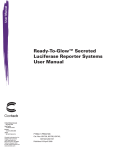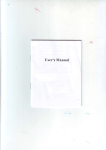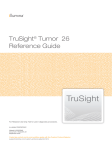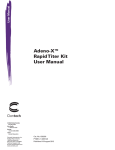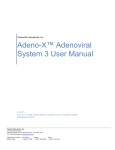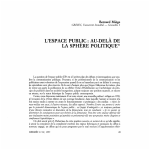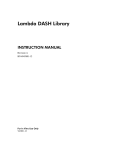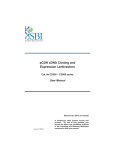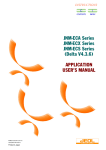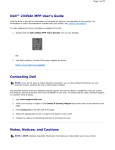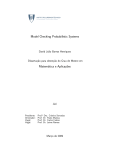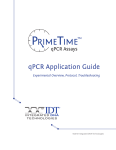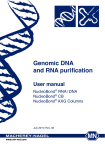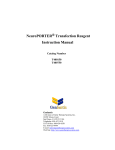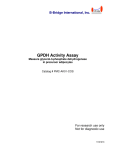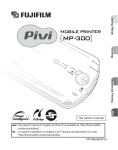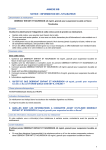Download Adeno-X Expression Systems 2 with Creator Technology Getting
Transcript
Adeno-X™ Expression Systems 2 with Creator™ Technology Getting Started PT3674-1 (PR782331) Published 8 August 2007 Adeno-X™ Expression Systems 2 User Manual Table of Contents I. Introduction & Protocol Overview 3 II. List of Components 7 III. Additional Materials Required 8 IV. General Considerations 11 V. Creator™ Adenoviral DNA Cloning Protocol 13 A. Creator™ DNA Cloning Procedure 13 B. PCR Colony Screening 14 C. Purifying Recombinant Adenoviral DNA (Midi-Scale) 16 D. PI-Sce I and I-Ceu I Restriction Analysis 17 E. Producing Recombinant Adenovirus 17 VI. Troubleshooting Guide 18 VII. References 19 Appendix A: Expected Results 20 Appendix B: Mini-Scale Purification of Adenoviral DNA 22 Appendix C: Adeno-X™ Acceptor Vector Information 23 List of Figures Figure 1. The loxP sequence, showing reading frame. Figure 2. Constructing recombinant adenovirus with Creator Technology. Figure 3. PCR colony screening. Figure 4. Plasmid map of pLP-Adeno-X-CMV Viral DNA. Figure 5. Plasmid map of pLP-Adeno-X-TRE Viral DNA. Figure 6. Plasmid map of pLP-Adeno-X-PRLS Viral DNA. 3 4–5 20 23 24 25 List of Tables Table I. Adeno-X™ Adenoviral Acceptor Vectors Table II. Set-up for PI-Sce I and I-Ceu I restriction analysis Table III. Expected results of PCR colony screening analysis Table IV. Expected results of restriction analyses Clontech Laboratories, Inc. www.clontech.com 6 17 20 21 Protocol No. PT3674-1 Version No. PR782331 Adeno-X™ Expression Systems 2 User Manual I. Introduction & Protocol Overview Welcome to the Adeno-X™ Expression System 2, a remarkably efficient cloning tool that lets you create recombinant adenoviral vectors quickly and easily using Cre-loxP site-specific recombination. With Cre-loxP cloning, any gene, up to ~7 kb in length, correctly inserted between loxP sites in a Creator™ Donor Vector can be transferred to a Adeno-X Acceptor Vector—the adenoviral genome—in a single enzymatic reaction. Cre-loxP site-specific recombination Cre-loxP recombination is the basis for our many Creator™ gene cloning and expression systems. The 15 minute in vitro reaction relies on the catalytic power of Cre, a 38 kDa recombinase protein from bacteriophage P1 that mediates recombination between or within DNA sequences at specific locations called loxP sites (Sauer, 1994; Abremski et al., 1984). These sites consist of two 13 bp inverted repeats separated by an 8 bp spacer region that provides directionality to the recombination reaction (Figure 1). The 8 bp spacer region in the loxP site has a defined orientation which forces your gene to be transferred in a fixed orientation and reading frame. Creator Donor Vectors contain two loxP sites, which flank the 5' end of an MCS and the 5' end of the open reading frame for the chloramphenicol resistance gene (Cmr; Figure 2). Donor Vectors also contain the ampicillin gene for propagation and selection in E. coli, and the sucrase gene from B. subtilis (SacB) for negative selection following Cre-loxP recombination. Adeno-X Acceptor Vectors (Table I) contain a single loxP site, followed by a bacterial promoter, which drives expression of the chloramphenicol marker after Cre-loxP-mediated recombination. The gene of interest, once transferred, will become linked to the specific expression elements for which the Acceptor Vector was designed. Furthermore, if the coding sequence for the gene of interest is in frame with the upstream loxP site in the Donor Vector, it will automatically be in frame with the expression elements in the Acceptor Vector. Therefore, you only need to determine the correct reading frame once, and your target gene will always be transferred in the correct reading frame and orientation in the Acceptor Vector after recombination 8-bp spacer region ATA ACT TCG TAT AGC ATA CAT TAT ACG AAG TTA T Left inverted repeat Right inverted repeat Figure 1. The loxP sequence, showing reading frame. Protocol No. PT3674-1 www.clontech.com Clontech Laboratories, Inc. Version No. PR782331 Adeno-X™ Expression Systems 2 User Manual I. Introduction & Protocol Overview continued and selection. Constructing adenoviral vectors with Creator™ Technology To transfer your gene from a Creator Donor Vector to a Adeno-X Acceptor Vector, combine the Donor Vector containing your gene of interest with Adeno-X LP Reaction Mix, a ready-to-use, pre-aliquoted solution composed of Cre Reaction Buffer, BSA, and pLP-Adeno-X Viral DNA—the adenoviral Acceptor Vector (Table I). Next, add Cre Recombinase and incubate at room temperature for 15 minutes. Cre binds to the loxP sites on both the Donor Vector and Acceptor Vector, cleaves the DNA, and then catalyzes strand exchange and ligation of the DNA. As a result, the gene of interest and chloramphenicol resistance gene are transferred in unison, as a single segment, from the Donor Vector to the Acceptor Vector (Figure 2). Recombinants can be isolated by transforming E. coli and selecting on medium containing both chloramphenicol and sucrose: chloramphenicol to select for cells containing recombinant vectors; sucrose to select against those with Donor Vectors. Following selection, recombinant clones should be positively identified by PCR, using the Adeno-X LP Primer Mix and the colony-screening protocol in this manual. The quick, easy colony-screening procedure serves as an important check before going ahead with the MidiScale Purification of your recombinant plasmid. Producing infectious adenovirus Infectious adenovirus is produced by transfecting your recombinant adenoviral vector into HEK 293 cells, an E1 trans-complementing cell line used for the production and propagation of ΔE1/ΔE3 adenovirus (Graham et al., 1977). Before transfection, however, the vector must first be digested with Pac I to linearize the DNA and to expose the inverted terminal repeats (ITRs) that flank the Adeno-X genome (Appendix D). The digestion, transfection, and propagation protocols are provided in the secondary User Manual supplied with your kit (Table I). Figure 2 (opposite page). Constructing recombinant adenovirus with Creator™ Technology. DNA sequences can be rapidly transferred from any Creator Donor Vector to any Adeno-X Acceptor Vector using Cre-loxP recombination. In this example, the Donor Vector is pDNRCMV, and the Acceptor Vector is pLP-Adeno-X-CMV. Donor Vectors contain two loxP sites, and Acceptor Vectors contain one loxP site. All three sites have the same orientation, defined by the loxP sequence (Figure 1), which maintains the directionality of the transferred gene. Each loxP site consists of an 8-bp spacer region, flanked by inverted repeats that serve as binding sites for Cre. Once the enzyme binds, it cleaves the DNA in the spacer region, and then reattaches the 5' end to the 3' end of another site having the same orientation. Multiple reactions between the two sites in the Donor Vector and the single loxP site in the Acceptor Vector occur simultaneously, resulting in the transfer of your gene of interest (GOI) and the chloramphenicol resistance gene into the Acceptor Vector. Products of recombination between or within individual Donor Vectors are eliminated in the next step, when transformants are plated on LB/Cm/sucrose. Donor Vectors and their derivatives all encode SacB, whose product inhibits E. coli growth on sucrose-containing media. The elements shown are not drawn to scale. For additional technical information, refer to our Creator home page: www.clontech. com/clontech/products/families/creator/index.shtml. Clontech Laboratories, Inc. www.clontech.com Protocol No. PT3674-1 Version No. PR782331 Adeno-X™ Expression Systems 2 User Manual I. Introduction & Protocol Overview continued Cre-loxP-mediated recombination SacB enov Ad iral (Ad 5) ge n om loxP Cmr e P pDNR-CMV loxP pLP-Adeno-X- Gene of interest PCMV IE CMV loxP ITR Pac I ITR PCMV IE Ampr Ampr Pac I pUC ori 1. Combine recombinant Donor Vector with Adeno-X LP Reaction Mix. 2. Add Cre recombinase. 3. Incubate for 15 min. loxP 3 days For protocol details, see PT3674-1. Prokaryotic Promoter Ad 5 P me no ge Cmr Recombinant adenoviral vector Gene of interest ITR loxP Recombinant adenoviral DNA Pac I pUC ori PCMVIE Ampr ITR Pac I 1. 2. 3. 4. 5. 6. ITR PCMV IE loxP GOI T0 Transform E. coli. Plate on LB/Cm/sucrose. Screen colonies by PCR. Inoculate overnight cultures. Purify recombinant adenoviral DNA. Digest with Pac I. (See secondary User Manual). Cmr loxP Poly A P ITR Ad5 genome Transfect low-passage HEK 293 cells. 2 weeks Viral replication & packaging For protocol details, see the secondary User Manual (Table I). 1. Harvest recombinant adenovirus. 2. Determine adenoviral titer. Adeno-X Rapid Titer Kit 3. [Optional] Purify adenovirus. Adeno-X Virus Purification Kit Protocol No. PT3674-1 www.clontech.com Version No. PR782331 Clontech Laboratories, Inc. Adeno-X™ Expression Systems 2 User Manual I. Introduction & Protocol Overview continued Adeno-X™ Acceptor Vectors We currently offer three different adenoviral Acceptor Vectors (Table I), allowing you to choose between three different modes of gene expression. • pLP-Adeno-X-CMV provides strong, constitutive expression of your gene of interest. This vector contains the immediate early promoter of human cytomegalovirus. • pLP-Adeno-X-TRE lets you regulate the expression of your gene in a dose-dependent manner, as explained in the Adeno-X Tet-ff & Tet-On Expression System 1 User Manual (PT3496-1). This vector contains a Tet-inducible promoter. • pLP-Adeno-X-PRLS, a promoterless vector, allows you to study gene expression from any promoter that you provide. Simply insert your promoter/gene sequence into the Donor Vector, and then follow the Creator Gene Cloning Protocol in this User Manual. Table I. Adeno-X™ Adenoviral Acceptor Vectors a Acceptor Vector Sold as part of Cat. No. Promoterb Secondary User Manualc pLP-Adeno-X-CMV 631524 Consitutive (PCMV IE) PT3414-1 pLP-Adeno-X-TRE 631058 Tet-inducible (PhCMV*–1) PT3496-1 pLP-Adeno-X-PRLS 631525 None PT3414-1 a See Appendix C for plasmid maps and complete descriptions of each Adeno-X Acceptor Vector. LP = loxP b PCMV IE is the immediate early promoter of human cytomegalovirus. PhCMV*–1 consists of the minimal CMV IE promoter (PminCMV) fused to seven tandem copies of the tet operator sequence (collectively referred to as the Tet-Responsive Element [TRE]) from Tn10 of E. coli (Gossen & Bujard, 1992). c Refer to these manuals for protocols on how to propagate, titer, and use infectious adenovirus. The infection protocols, and thus User Manuals, differ for constitutive and Tet-inducible adenovirus. About this User Manual This manual explains how to construct recombinant adenoviral DNA using Creator Technology. To produce infectious adenovirus, you need to refer to the secondary User Manual supplied with your system (see Table I). The secondary manual provides protocols for propagating infectious adenovirus, determining adenoviral titer, and infecting target cells. • For Tet-inducible adenoviral vectors, refer to the Adeno-X Tet-Off & Tet-On Expression Systems 1 User Manual (PT3496-1). • For all other adenoviral vectors, refer to the Adeno-X Expression System 1 User Manual (PT3414-1). • To learn more about Creator™ Technology, see our Creator Cloning Kits User Manual (PT3460-1) available at www.clontech.com. Clontech Laboratories, Inc. www.clontech.com Protocol No. PT3674-1 Version No. PR782331 Adeno-X™ Expression Systems 2 User Manual II. List of Components Upon receipt, store Cre Recombinase at –70°C. But after the first thaw, store Cre Recombinase at –20°C in a non-frost-free freezer. Store virus stock at –70°C. Store all other components at –20°C. Each kit includes sufficient reagents to perform 5 reactions. Adeno-X™ Expression System 2 (Cat. No. 631524) • 5 x 18 µl Adeno-X LP CMV Reaction Mixa • 20 µg pDNR-CMV Vector (500 ng/µl) • 5 µl Cre Recombinase • 100 µl Adeno-X LP CMV Primer Mixb • Vector Information Packet (PT3675-5) Adeno-X™ Tet-Off Expression System 2 (Cat. No. 631058) • 5 x 18 µl Adeno-X LP TRE Reaction Mixa • 20 µg pDNR-CMV Vector (500 ng/µl) • 100 µl Adeno-X Tet-Off Virus Stock (~1 x 108 pfu/ml)c • 5 µl Cre Recombinase • 100 µl Adeno-X LP TRE Primer Mixb • 50 ml Tet System Approved FBS, US-Sourced • Vector Information Packet (PT3675-5) Adeno-X™ Promoterless Expression System 2 (Cat. No. 631525) • 5 x 18 µl Adeno-X LP PRLS Reaction Mixa • 20 µg pDNR-1r Vector (500 ng/µl) • 5 µl Cre Recombinase • 100 µl Adeno-X LP PRLS Primer Mixb • Vector Information Packet (PT3616-5) a Contains pLP-Adeno-X plasmid DNA (the Acceptor Vector; see Table I), Cre reaction buffer, and bovine serum albumin (BSA). b Contains Forward Primer 1, Forward Primer 2, and Reverse Primer; 20 µM each. Primer Sequences can be found on the Product Analysis Certificate. c Virus stock should be retitered and amplified upon receipt. Protocol No. PT3674-1 www.clontech.com Clontech Laboratories, Inc. Version No. PR782331 Adeno-X™ Expression Systems 2 User Manual III. Additional Materials Required The following materials are required but not supplied: • Electrocompetent E. coli cells The following cell type is suitable for use with the Adeno-X Expression System 2: • Supercharge EZ10 Electrocompetent Cells (Cat. No. 636756) Transformation by electroporation is required when using the large (~36 kb) pAdeno-X vectors. We strongly recommend using this cell type. Other competent cells or strains may be either insufficiently competent or unsuitable for propagating the large vectors. • Chloramphenicol stock solution (Cm) (30 mg/ml in 100% ethanol; 1,000X.) Store at –20°C. • Ampicillin stock solution (Amp) (100 mg/ml in H2O; 1,000X.) Store at –20°C. • SOC Medium (Review Section V.A to estimate the volume you will need. The following recipe makes 1 L.) 1.To 800 ml of deionized H2O, add: 20g Bactotryptone 5g Yeast extract 2.Stir until dissolved. 3.Add: 2.5ml 1 M KCl 10ml 1 M NaCl 10ml 1 M MgCl2 10ml 1 M MgSO4 20ml 1 M glucose 4.Stir until dissolved. 5.Adjust the volume to 1 L by adding deionized H2O. 6.Sterilize by autoclaving for 20 min at 121°C. Note: Autoclaving for longer than 20 min may cause the glucose to burn. • LB Liquid Broth, 1X (Review Section V.B–C to estimate the volume you will need. The following recipe makes 1 L.) 1.To 750 ml of deionized H2O, add: 10g Bactotryptone 5g Yeast extract 5g NaCl 2.4g MgSO4 2.Stir until dissolved. Clontech Laboratories, Inc. www.clontech.com Protocol No. PT3674-1 Version No. PR782331 Adeno-X™ Expression Systems 2 User Manual III. Additional Materials Required continued 3.Adjust the volume to 1 L by adding deionized H2O. 4.Sterilize by autoclaving for 40 min at 121°C. • LB agar/30 µg/ml chloramphenicol/ 7% sucrose plates (100 mm) Available fromTeknova, Inc., Cat. No. L1806, or prepare your own. Review Section V.A to estimate the volume you will need. The following recipe makes 1 L. 1.To 750 ml of deionized H2O, add 70 g sucrose. 2.Stir until dissolved. 3.Add: 10g Bactotryptone 5g Yeast extract 10g NaCl 4.Stir until dissolved. Then add 15 g Bacto Agar. Continue stirring until dissolved. 5.Adjust the volume to 1 L by adding deionized H2O. 6.Sterilize by autoclaving for 20 min at 121°C. Remove from the autoclave immediately when done. 7.After the solution has cooled to ~50°C, add 1 ml of filter sterilized 30 mg/ml chloramphenicol. Mix the solution briefly. 8.Pour 30 ml per 100 mm plate. Cover the plates and allow them to dry. 9.To check for possible contamination, incubate a plate at 37°C overnight. Check for growth the following day. • T4 DNA Ligase • Agarose and EtBr • Sterile, deionized H2O • PCR reagents for PCR Colony Screening The following PCR kits from Clontech have been tested and approved for use with the PCR Colony Screening Protocol (Section V.B): – TITANIUM™ Taq PCR Kit (Cat. No. 639210) – Sprint™ Advantage™ 96 Plate (Cat. No. 639550) – Sprint™ Advantage™ Single Shots (Cat. No. 639553); many sizes available) • NucleoBond® Plasmid Midi Kit (Cat. No. 635929; many sizes available) For Midi-Scale purification of Donor Vector and adenoviral plasmid DNA. • [Optional] NucleoBond® Plasmid Maxi Kit (Cat. No. 635933; many sizes Protocol No. PT3674-1 www.clontech.com Version No. PR782331 Clontech Laboratories, Inc. Adeno-X™ Expression Systems 2 User Manual III. Additional Materials Required continued available) For Maxi-Scale purification of Donor Vector DNA. • 1X TE Buffer (10 mM Tris-HCl [pH 8.0]; 1 mM EDTA) • Ethanol (100% and 70%) • [Optional] Restriction Endonucleases PI-Sce I and I-Ceu I (Available from Clontech; Cat. No. 631027) These enzymes can be used to verify recombinant pLP-Adeno-X constructs. See Section V.D for a protocol and Appendix C for plasmid maps. Expected band sizes are described in Table IV, Appendix A. • Restriction Endonuclease Xho I (New England Biolabs) Xho I may be used to verify recombinant pLP-Adeno-X constructs. See Appendix C for plasmid maps. Expected band sizes are described inTable IV, Appendix A. • [Optional] Buffers for Mini-Scale Purification of adenoviral DNA. See Appendix B: Buffer 1: 25 mM Tris-HCl (pH 8.0), 10 mM EDTA, 50 mM glucose Autoclave and store at 4°C. Buffer 2: 0.2 M NaOH, 1% SDS Prepare fresh, just prior to use. Keep tightly capped and at room temperature. Buffer 3: 5 M KOAc Autoclave and store at 4°C. Buffer 4: 10 mMTris-HCl (pH 8.0), 1 mM EDTA, 20 µg/ml RNase (boiled to inactivate DNase) Add RNase just before use. Store at –20°C after adding RNase (Shelf-life ≤ 6 months). In general, it is not advisable to store RNase solutions near RNase-free solutions. • [Optional] Phenol:chloroform:isoamyl alcohol (25:24:1) Equilibrate with 100 mM Tris-HCl, pH 8.0. Used for mini-scale purification of adenoviral DNA. • For producing and analyzing adenovirus, please also see the List of Additional Materials Required in the Adeno-X Expression System 1 User Manual that corresponds to your system (See Table I under “Secondary User Manual”). These manuals contain protocols for propagating recombinant adenovirus, determining adenoviral titer, and infecting target cells. Clontech Laboratories, Inc. www.clontech.com 10 Protocol No. PT3674-1 Version No. PR782331 Adeno-X™ Expression Systems 2 User Manual IV. General Considerations A. Cloning with Creator™ Technology • The following Creator Donor Vectors may be used for gene cloning and Cre-loxP-mediated gene transfer to any Adeno-X Acceptor Vector: – pDNR-Dual – pDNR-Lib – pDNR-1r – pDNR-CMV • Although the reading frame of the insertion is only significant when transferring into Acceptors Vectors that express fusion proteins, we strongly encourage you to clone your gene of interest in frame with the Donor Vector’s upstream loxP site to ensure compatibility with all of our Acceptor Vectors. • To ensure that protein-tag fusions constructed in pDNR-Dual will be correctly expressed, the gene insert should have neither stop codons nor a 3' UTR. • pDNR-CMV is both a cloning vector and an expression vector. It contains the immediate early promoter of human cytomegalovirus (PCMV IE) located just upstream, and an SV40 polyadenylation signal just downstream, of the MCS so that you can test the expression and functionality of your insert before transferring it to an Acceptor Vector. We recommend you perform this test for each pDNR-CMV construct. • Following site-specific recombination, Cre recombinase is inactivated by heating the reaction mix to 70°C. The reaction cannot be stopped by placing the reaction on ice, because the enzyme remains active even at these low temperatures. • Sucrose and chloramphenicol are required for the initial selection of correct recombinants. After initial selection on LB/Cm/Sucrose, recombinant clones should be grown in LB liquid broth that contains chloramphenicol and ampicillin, for strict propagation of recombinant pLP-Adeno-X Viral DNA. • For the highest possible recombination efficiency, we recommend you purify your recombinant Donor Vector using a NucleoBond Plasmid Midi or Maxi Kit (see Related Products). • Verify plasmid DNA concentration by gel electrophoresis and by OD260 before performing the recombination reaction. Protocol No. PT3674-1 www.clontech.com Version No. PR782331 Clontech Laboratories, Inc. 11 Adeno-X™ Expression Systems 2 User Manual IV. General Considerations continued B. Purifying Recombinant Adeno-X™ Adenoviral DNA pLP-Adeno-X Viral DNA is a large plasmid that is susceptible to damage and rearrangement in E. coli.When maintained in culture for long periods, adenoviral DNA can become resistant to digestion. In some cases, the E. coli host may modify the plasmid, producing smaller derivatives that eventually outgrow the original construct. To avoid such aberrations, always start with freshly transformed cells, not glycerol stocks. Always use fresh, log-phase cultures as your source of recombinant pLP-Adeno-X plasmid DNA. Do not store a culture at room temperature, 4°C, or on ice for long periods (i.e., >24 hr) before starting a purification or inoculating a second culture. To minimize the culture time, you should work as follows. After plating transformants on LB/Cm/sucrose plates (Section V.A), pick the resulting colonies as soon as possible (i.e., within 24 hours).Without delay, amplify the clones in 5 ml of LB/Amp/Cm liquid broth. Meanwhile, perform PCR analysis (Section V.B). If PCR confirms the presence of a recombinant pLP Adeno-X construct, transfer a portion of the corresponding 5 ml, log-phase culture to 100 ml of fresh LB/Amp/Cm broth to further amplify the clone. When this culture reaches log phase, harvest your construct using the NucleBond Midi-Scale procedure, as described in Section V. NucleoSpin Kits should not be used to purify pLP-Adeno-X DNA. C. Mini-Scale Purification of Adenoviral DNA Appendix B provides a Mini-Scale Purification Protocol for isolating recombinant adenoviral DNA from 5-ml, log-phase cultures. The adenoviral DNA prepared with this protocol may be used for confirming constructs by restriction analysis or for transforming E. coli to produce fresh clones. In general, however, the quality and quantity of the adenoviral DNA prepared with the Mini-Scale method are inadequate for producing adenovirus. Thus, we do not recommend you use Mini-Scale DNA for transfecting HEK 293 cells. Clontech Laboratories, Inc. www.clontech.com 12 Protocol No. PT3674-1 Version No. PR782331 Adeno-X™ Expression Systems 2 User Manual V. Creator™ Adenoviral DNA Cloning Protocol PLEASE READ ENTIRE PROTOCOL BEFORE STARTING. A. Creator™ DNA Cloning Procedure 1.Subclone your gene of interest into the Donor Vector using standard methods (Sambrook & Russell, 2001). For detailed information about the multiple cloning site in your Donor Vector, refer to the Vector Information Packet supplied with your system. These packets are also available on our web site. Note: In-Fusion™ PCR Cloning Kits (Cat. No. 631774) enable you to clone PCR products without the need for restriction enzymes, ligase, or blunt-end polishing. 2.Set up a Creator reaction mixture: 1µl(200 ng) 1µl 18µl 20µl Recombinant Donor Vector Cre Recombinase Adeno-X LP Reaction Mix Total volume Important: The first time you use Cre Recombinase, thaw rapidly from –70°C by holding the tube between your fingers until almost all of the ice is melted. Then place the tube on ice. Once thawed, the Cre Recombinase should be stored at –20°C in a non-frostfree freezer. At –20°C, the Cre solution will remain in the liquid state and will not need to be thawed again before use. 3.Mix well by gently tapping the tube. Spin briefly. 4.Incubate at room temperature for 15 min. Note: Do not extend incubation past 15 min; competing recombination reactions, which do not generate desired recombinants, can reduce the yield of your desired recombinants. 5.Stop the reaction by heating tube at 70°C for 5 min. 6.Transform 40–50 µl of Supercharge EZ10 ElectroCompetent cells with 1–2 µl of reaction mixture. Notes: • We usually transform 40 µl of Supercharge EZ10 ElectroCompetent cells with 1.5 µl of reaction mixture. • The transformation efficiency of the competent cells should be >5 x 109 cfu/µg. If not, replace with a fresh sample of cells. 7.Grow cells at 37°C for 60 min in 1 ml of SOC medium. Note: We usually transfer the transformation mixture (~40 µl) into 960 µl of SOC. 8.Transfer the cells to a centrifuge tube and spin at 6,000 rpm for 1 min. Protocol No. PT3674-1 www.clontech.com Version No. PR782331 Clontech Laboratories, Inc. 13 Adeno-X™ Expression Systems 2 User Manual V. Creator™ Adenoviral DNA Cloning Protocol cont. 9.Resuspend the cell pellet in 50–100 µl of fresh SOC medium. 10.Spread the entire cell suspension on a single 10 cm LB-agar plate containing 30 µg/ml chloramphenicol, and 7% sucrose (w/v). Incubate at 37°C for 24–30 hours. Allow the inoculum to soak into the plate thoroughly before starting the incubation. We usually let the plate sit undisturbed on the bench top for 15–20 min before transferring it to the incubator. Note: These transformants grow slowly because the growth conditions are stringent and because the adenoviral plasmid is large. It may take up to 24 hours, and perhaps longer, for colonies to appear. 11.The next day, screen colonies for recombinant pLP-Adeno-X DNA by PCR using the Adeno-X LP Primer Mix provided with your system and the protocol described in Part B. B. PCR Colony Screening The following PCR kits from Clontech have been tested and approved for use with the PCR Colony Screening Protocol: – TITANIUM™ Taq PCR Kit (Cat. No. 639210) – Sprint™ Advantage™ 96 Plate (Cat. No. 639550) – Sprint™ Advantage™ Single Shots (Cat. No. 639553; many sizes) Follow the protocol below that corresponds to your PCR kit. TITANIUM™ Taq PCR Kit—Colony Screening Protocol 1.Using a sterile toothpick or pipette tip, transfer a single, randomly chosen colony into 20 µl of deionized H2O. We typically screen about 10 colonies. 2.Resuspend the colony by gently vortexing or by pipetting up and down. 3.Transfer 10 µl of the suspension into 5 ml of LB liquid broth containing 100 µg/ml ampicillin and 30 µg/ml chloramphenicol (LB/ Amp/Cm). 4.Incubate at 37°C with shaking for 6–8 hr. 5.Meanwhile, analyze the remaining 10 µl of cell suspension by PCR: a.Set up the PCR reaction. For a single reaction: 10µl PCR-Grade Water 10µl E. coli. cells (suspended in H2O as described in Step 1) 2.5µl 10X TITANIUM™ Taq PCR Buffer 1µl Adeno-X LP Primer Mix Clontech Laboratories, Inc. www.clontech.com 14 Protocol No. PT3674-1 Version No. PR782331 Adeno-X™ Expression Systems 2 User Manual V. Creator™ Adenoviral DNA Cloning Protocol cont. 1µl dNTP Mix (10 mM ea. of dATP, dCTP, dGTP, dTTP) 0.5µl 50X TITANIUM™ Taq DNA Polymerase 25µl Total volume b.Mix well by vortexing or pipetting up and down, and then centrifuge the tube (or plate) briefly to collect the liquid. c.If your thermal cycler does not have a "hot lid": add 1–2 drops of mineral oil to prevent evaporation during cycling. A good "seal" of mineral oil should have a well-defined meniscus between the two phases. Cap the PCR tubes firmly. d.Commence thermal cycling using the following parameters: • 95°C for 2 min • 20 cycles 94°C for 15 sec 64°C for 30 sec 68°C for 30 sec Note: These parameters are optimized for hot-lid thermocyclers. e.Add 2.5 µl of 10X DNA-loading dye to the PCR reaction, and then analyze a 5-µl aliquot on a 1.8% agarose/ethidium bromide gel, along with suitable DNA size markers. Expected results: See Appendix A. 6.Proceed with Part C, below. Sprint™ Advantage™ 96 Plate or Single Shot—Colony Screening Protocol 1.Prepare a sufficient volume of Suspension Mix. For each colony, combine: 49µl Deionized H2O 1µl Adeno-X LP Primer Mix 50µl Total volume If you are screening multiple colonies, increase the volumes proportionally. For example, to screen 10 colonies, combine 490 µl of H2O with 10 µl of Adeno-X LP Primer Mix. 2.Using a sterile toothpick or pipette tip, transfer a single, randomly chosen colony into 50 µl of Suspension Mix (prepared in Step 1). 3.Resuspend the colony by gently vortexing or by pipetting up and down. 4.Transfer 25 µl of the suspension into 5 ml of LB liquid broth containing 100 µg/ml ampicillin and 30 µg/ml chloramphenicol (LB/Amp/Cm). Protocol No. PT3674-1 www.clontech.com Version No. PR782331 Clontech Laboratories, Inc. 15 Adeno-X™ Expression Systems 2 User Manual V. Creator™ Adenoviral DNA Cloning Protocol cont. 5.Incubate at 37°C with shaking for 6–8 hr. 6.Transfer the remaining 25 µl of cell suspension into one well of a Sprint 96 Plate or Single Shot. 7.Cap the well(s) with the PCR Cap Strips or Microseal A Film. 8.Mix well by vortexing, and then centrifuge the tube (or plate) briefly to collect the liquid. Note: If you are using a 96 Plate, and you do not have access to a suitable centrifuge, tap or flip the Plate until the reaction mix returns to the bottom of the wells. 9.Commence thermal cycling using the following parameters: • 95°C for 2 min • 20 cycles 94°C for 15 sec 64°C for 30 sec 68°C for 30 sec Note: These parameters are optimized for hot-lid thermocyclers. 10.Add 2.5 µl of 10X DNA-loading dye to the reaction, and then analyze a 5-µl aliquot on a 1.8% agarose/ethidium bromide gel, along with suitable DNA size markers. Expected results: See Appendix A. 11.Proceed with Part C, below. C. Purifying Recombinant Adenoviral DNA (Midi-Scale) Once you identify a positive clone by PCR, amplify the clone by inoculating 100 ml of LB/Amp/Cm liquid broth (100 µg/ml ampicillin and 30 µg/ml chloramphenicol) with 2–5 ml of fresh, log-phase culture—e.g., the culture you set up in Section V.B*. Incubate the 100-ml culture at 37°C until it reaches log-phase. Then purify the plasmid using a NucleoBond® Plasmid Midi Kit (see Related Products). Follow the Low Copy Plasmid Purification Protocol in the NucleoBond User Manual (PT3167-1). In following this protocol, use filtration, not centrifugation, to clarify the bacterial lysate. Expected Yield: 30–50 µg plasmid DNA/100 ml of culture * If desired, you may use a portion of this culture for a Mini-Scale Purification of the adenoviral plasmid (Appendix B). But first, see Section IV.C. Note: pLP-Adeno-X Viral DNA is susceptible to damage and rearrangement in E. coli. For best results, always use fresh, log-phase cultures for purification of recombinant pLP-Adeno-X DNA. Do not store your culture at room temperature, 4°C, or on ice for long periods (i.e., >24 hr) before starting the purification or before inoculating a second culture. When you finish the NucleoBond purification, reconfirm the identity of your recombinant Adeno-X plasmid using one or both of the restriction analyses listed below. Clontech Laboratories, Inc. www.clontech.com 16 Protocol No. PT3674-1 Version No. PR782331 Adeno-X™ Expression Systems 2 User Manual V. Creator™ Adenoviral DNA Cloning Protocol cont. Restriction Analyses: – Xho I digestion: Follow the manufacturer’s specifications. For best resolution: Digest 1 µg of adenoviral DNA for 3 hrs, and then load half of the digest on a 15 x 15 cm, 0.8% (or 1%) agarose gel. Run the gel at ~30 V overnight. – PI-Sce I and I-Ceu I double digestion: See Part D, below. Analyze the digestion products on a 0.8–1% agarose/EtBr gel. Compare your results to those in Table IV (Appendix A). See Appendix C for plasmid maps and restriction sites. D. PI-Sce I and I-Ceu I Restriction Analysis 1.Set up 30-µl PI-Sce I/I-Ceu I double digests by combining the reagents shown in Table II in a sterile 1.5 ml microcentrifuge tube. Table II. Set-up for PI-Sce I and I-Ceu I Restriction Analysis Reagent Volume Sterile H2O 19.5µl 10X Digestion Buffer 3.0µl Recombinant pLP-Adeno-X DNA (500 ng/µl) 2.0µl PI-Sce I Restriction Enzyme (1 unit/µl) 2.0µl I-Ceu I Restriction Enzyme (5 units/µl) 0.5µl 10X BSA 3.0µl Total Volume 30.0µl 2.Mix well and spin briefly to collect contents. 3.Incubate at 37°C for exactly 3 hours. Important: For best results, this incubation time must be strictly observed. 4.Analyze the digestion products on a 0.8–1% agarose/EtBr gel. Compare your results to those in Table IV, Appendix A. Important: I-Ceu I and PI-Sce I often remain bound to the DNA. Use a gel loading buffer that contains SDS (final concentration after combining with sample: 0.1%). E. Producing Recombinant Adenovirus Infectious adenovirus is produced by transfecting HEK 293 cells with Pac I-digested pLP-Adeno-X DNA. These protocols are provided in the secondary Adeno-X Expression System User Manual supplied with your kit (Table I). Go to the Section entitled “Producing Recombinant Adenovirus.” Protocol No. PT3674-1 www.clontech.com Version No. PR782331 Clontech Laboratories, Inc. 17 Adeno-X™ Expression Systems 2 User Manual VI. Troubleshooting Guide No or few colonies Low transformation efficiency • Check transformation efficiency. You should obtain >5 x 109 cfu/µg; otherwise use new, fresh competent cells. Too much Cre used in the reaction • To ensure that an accurate volume of Cre recombinase is added to the reaction mix, use a 2 or 10 µl pipettor. Cell type used • Be sure you are using a suitable E. coli cell type. See List of Additional Materials Required (Section III) for a list of recommended cell types. Incubation of reaction exceeded 15 minutes • Do not incubate the Creator Reaction Mixture longer than 15 minutes. Competing recombination events can reduce the yield of your desired recombinants. For this reason, it is critical that you closely monitor the reaction time. Afterwards, be sure to inactivate the Cre enzyme, and thus stop the reaction, by heating the mixture to 70°C as directed in the protocol. If you inadvertently skip the heating step and simply place the mixture on ice, the reaction is likely to continue because Cre remains active even at low temperatures. Poor quality (impure) plasmid DNA • For best results, use only highly pure plasmid DNA. We suggest you use a NucleoBond Plasmid Midi or Maxi Kit to purify Donor Vector DNA.To purify recombinant pLP-Adeno-X DNA, use the NucleBond Midi-Scale procedure in Section V. NucleoSpin Kits should not be used to purify pLP-Adeno-X DNA. • To accurately determine plasmid DNA concentration, analyze an aliquot of your miniprep, alongside a molecular weight standard, on a 0.8–1.0% agarose/EtBr gel. Photograph the gel and compare the band intensity of the plasmid to the band intensities of the DNA size markers to quantify. In addition, check the concentration using the OD260 method. Clontech Laboratories, Inc. www.clontech.com 18 Protocol No. PT3674-1 Version No. PR782331 Adeno-X™ Expression Systems 2 User Manual VII. References Abremski, K. & Hoess, R. (1984) Bacteriophage P1 site-specific recombination. Purification and properties of the Cre recombinase. J. Biol. Chem. 259:1509–1514. Barabino S. M. L. & Keller, W. (1999) Last but not least: regulated Poly(A) Tail Formation. Cell 99:9–11. Creator DNA Cloning & Expression System (April 2000) Clontechniques XI(2):7–11. Gossen, M. & Bujard, H. (1992) Tight control of gene expression in mammalian cells by tetracycline responsive promoters. Proc. Natl. Acad. Sci. USA 89:5547–5551. Graham, F. L., Smiley, J., Russel, W. C. & Nairn, R. (1977) Characterization of a human cell line transformed by DNA from human adenovirus type 5. J. Gen. Virol. 36:59–72. Guo, F., Gopaul, D. N. & Van Duyne, G. D. (1997) Structure of Cre recombinase complexed with DNA in a site-specific recombination synapse. Nature 389:40–46. Hackett, N. R. & Crystal, R. G. (2000) Adenovirus Vectors for Gene Therapy. In Gene Therapy: Therapeutic Mechanisms and Strategies. Eds. Templeton, N. S. & Lasic, D. D. (Marcel Dekker), pp 17–40. Lilley, D. M. J. (1997) Site-specific recombination caught in the act. Chem. Biol. 4:717–720. Mizuguchi, H. & Kay, M. A. (1999) A simple method for constructing E1- and E1/E4-deleted recombinant adenoviral vectors. Hum. Gene Ther. 10:2013–2017. Mizuguchi, H. & Kay, M. A. (1998) Efficient construction of a recombinant adenovirus vector by an improved in vitro ligation method. Hum. Gene Ther. 9:2577–2583. Sambrook, J. & Russell, D. W. (1989) Molecular Cloning: A Laboratory Manual, Second Edition (Cold Spring Harbor Laboratory, Cold Spring Harbor, NY). Sauer, B. (1994) Site-specific recombination: developments and applications. Curr. Opin. Biotechnol. 5:521–527. Protocol No. PT3674-1 www.clontech.com Version No. PR782331 Clontech Laboratories, Inc. 19 Adeno-X™ Expression Systems 2 User Manual Appendix A: Expected Results Table III. Expected results of PCR colony screening Analysis Acceptor Vector Expected Band Sizes* (Using the appropriate Adeno-X LP Primer Mix) Recombinant Non-Recombinant pLP-Adeno-X-CMV 660 bp 269 bp pLP-Adeno-X-TRE 660 bp 218 bp pLP-Adeno-X-PRLS 660 bp 170 bp *In rare cases, a colony may contain both recombinant and non-recombinant vectors. If this happens, you will observe two bands. These colonies should not be used as a source of recombinant pLP-Adeno-X DNA. A Forward Primer 2 660 bp Reverse Primer 1 Forward Primer 1 pLP-Adeno-X loxP GOI Cmr T0 loxP Poly A P Recombinant pLP-Adeno-X Viral DNA B Forward Primer 1 pLP-Adeno-X <300 bp See Table III for exact size. Reverse Primer 1 LP Poly A P Non-Recombinant pLP-Adeno-X Viral DNA Figure 3. PCR Colony Screening. E. coli clones containing recombinant pLP-Adeno-X Viral DNA are rapidly identified by PCR using the Adeno-X LP Primer Mix. The Primer Mix is composed of three primers: two Forward and one Reverse (20 µM each). Whereas recombinant constructs share homology to all three primers (Panel A), non-recombinant constructs share homology to Forward Primer 1 and Reverse Primer 1 only (Panel B). In principle, recombinant constructs could give rise to two bands, but in practice only one band is observed because the thermocycling parameters favor the 660 bp segment amplified by Forward Primer 2 and Reverse Primer 1 (Panel A). In contrast, non-recombinant pLP-Adeno-X Vectors lack both a gene of interest (GOI) and the chloramphenicol resistance gene (Cmr) that is necessary for hybridization to Forward Primer 2; thus, non-recombinant vectors hybridize with only two of the primers: Forward Primer 1 and Reverse Primer 1, which amplify a short segment of DNA (Panel B). The elements shown are not drawn to scale. Clontech Laboratories, Inc. www.clontech.com 20 Protocol No. PT3674-1 Version No. PR782331 Adeno-X™ Expression Systems 2 User Manual Appendix A: Expected Results continued Table IV. Expected results of Restriction Analyses Acceptor Vector Expected Band Sizes (kb) Xho I PI-Sce I/I-Ceu I pLP-Adeno-X-CMV 14.5, 8.0, 7.6a, 2.5, 1.4 & 0.6 32.7 & 1.9b pLP-Adeno-X-TRE 14.5, 8.0, 3.8a, 3.6, 2.5, 1.4 & 0.6 32.7 & 1.7b pLP-Adeno-X-PRLS 14.5, 8.0, 6.9a, 2.5, 1.4 & 0.6 32.7 & 1.3b a A portion of this band corresponds to the region containing the loxP site. Therefore, the size of this band will change if a target gene and, therefore, chloramphenicol resistance gene have been transferred into the vector by Cre-loxP recombination. Furthermore, the number and size of the bands observed for recombinant constructs will depend on whether or not your gene of interest contains one or more Xho I sites. b This band corresponds to the region containing the loxP site.Therefore, the size of this band will change if a target gene and, therefore, chloramphenicol resistance gene have been inserted into the vector. In rare cases, the gene of interest itself may contain a PI-Sce I site, I-Ceu I site, or both. If so, the number and size of the bands observed will change proportionally. Protocol No. PT3674-1 www.clontech.com Clontech Laboratories, Inc. Version No. PR78233121 Adeno-X™ Expression Systems 2 User Manual Appendix B: Mini-Scale Purification of Adenoviral DNA Mini-Scale Purification of Recombinant pLP-Adeno-X Plasmid DNA This protocol uses a series of buffers (Buffers 1–4) that you will need to prepare beforehand. The compositions of Buffers 1–4 are described in Section III. Expected yield: ~5–10 µg plasmid DNA per 3–5 ml of culture. 1.Centrifuge 3–5 ml of fresh, log-phase culture at 14,000 rpm for 15–30 sec. Carefully decant the supernatant. 2.Spin the pellet once again at 10,000 rpm for 1 min. Use a micropipette to aspirate the residual supernatant. 3.Resuspend the pellet in 150 µl of Buffer 1 by gently pipetting up and down. 4.Add 150 µl of Buffer 2 to the suspension. Mix gently by inverting the tube several times. Incubate the cell suspension at room temperature for 5 min. 5.Add 150 µl of Buffer 3. Mix gently by inverting the tube several times. Place the cell suspension on ice for 5 min. 6.Centrifuge the suspension at 14,000 rpm for 5 min at 4°C. 7.Transfer the clear supernatant to a clean 1.5-ml microcentrifuge tube. 8.Add 450 µl of phenol:chloroform:isoamyl alcohol (25:24:1) to the supernatant. Mix by inversion. 9.Centrifuge for 5 min at 4°C to separate the phases. 10.Carefully transfer the top aqueous layer to a clean 1.5-ml microcentrifuge tube. Discard the interface and lower phase into an organic waste container. 11.Add 1 ml 95% ethanol. Mix thoroughly by inversion. 12.Centrifuge at 14,000 rpm for 10 min at 4°C. 13.Remove and discard the supernatant. 14.Add 1 ml 70% ethanol then centrifuge for 2 min at room temperature. 15.Remove and discard the supernatant. 16.Allow the pellet to dry at room temperature. 17.When the pellet is dry, dissolve the DNA precipitate in 15–30 µl of Buffer 4. Incubate at room temperature for 10 min. 18.Vortex gently. 19.Spin briefly to recover contents. Store at –20°C. 20.Identify the recombinant by restriction analysis (Section V.C). Clontech Laboratories, Inc. www.clontech.com 22 Protocol No. PT3674-1 Version No. PR782331 Adeno-X™ Expression Systems 2 User Manual Appendix C: Adeno-X™ Acceptor Vector Information Pac I (34606) Pac I (34616) I-Ceu I (353) pUC ori ITR PCMV IE Ampr pLP-Adeno-X-CMV Xho I (31678) 34.6 kb ITR Pac I ΔE1: 342–3528 ΔE3: 27865–30995 ΔE 1 /ΔE3 Ad5 genome (31643) loxP P SV40 poly A PI-Sce I (2310) Xho I (4626) Xho I (7092) Xho I (8537) Xho I (9132) Xho I (23632) Figure 4. Plasmid map of pLP-Adeno-X-CMV Viral DNA. Unique restriction sites are in bold. Description pLP-Adeno-X-CMV is an Acceptor Vector that contains a ΔE1/ΔE3, replication-deficient adenoviral type 5 (Ad5) genome engineered for use in gene delivery and expression studies (Mizuguchi & Kay, 1998, 1999; Adeno-X Expression System User Manual [PT3414-1]). Instead of a multiple cloning site, pLP-Adeno-X-CMV contains a loxP site from P1 bacteriophage (Sauer, B., 1994). Thus, a gene of interest can be directly transferred from a Creator Donor Vector into the adenoviral genome using Creator Cre-loxP site-specific recombination. The loxP site in pLP-Adeno-X-CMV is located downstream of the immediate early promoter of human cytomegalovirus (PCMV IE), a strong consitutive promoter that drives expression of the transgene in mammalian host cells. There is a bacterial promoter (P) adjacent to the loxP site to drive expression of the chloramphenicol resistance gene (Cmr) that is transferred from the Donor Vector along with the gene of interest. The nucleotide sequences deleted (Δ) from the parental, wild-type Ad5 genome are indicated in the figure. Whereas E1 encodes trans-acting proteins that are essential for viral replication and transcription, E3 is dispensable for the propagation of the virus in culture (Hackett & Crystal, 2000). Inverted terminal repeats (ITR), which are necessary for the replication of adenoviral DNA, flank the Ad5 genome. pLP-Adeno-X-CMV also contains a pUC replication origin and an ampicillin resistance gene (Ampr) for propagation and selection in E. coli. Protocol No. PT3674-1 www.clontech.com Clontech Laboratories, Inc. Version No. PR78233123 Adeno-X™ Expression Systems 2 User Manual Appendix C: Acceptor Vector Information continued Pac I (34377) pUC ori Pac I (34387) I-Ceu I (353) Xho I (610) ITR TRE PhCMV*–1 PminCMV r Amp pLP-Adeno-X-TRE Xho I 34.4 kb (31449) P SV40 poly A ΔE1: 342–3528 ΔE3: 27865–30995 ITR Pac I loxP Xho I (4397) Xho I (6863) Xho I (8308) e ΔE 1 /ΔE3 Ad5 genom (31414) Xho I PI-Sce I (2081) Xho I (8903) (23403) Figure 5. Plasmid map of pLP-Adeno-X-TRE Viral DNA. Unique restriction sites are in bold. Description pLP-Adeno-X-TRE is an Acceptor Vector that contains a ΔE1/ΔE3, replicationdeficient adenoviral type 5 (Ad5) genome engineered for use in gene delivery and expression studies (Mizuguchi & Kay, 1998, 1999; Adeno-X Tet-Off & Tet-On Expression System 1 User Manual [PT3496-1]). Instead of a multiple cloning site, pLP-Adeno-X-TRE contains a loxP site from P1 bacteriophage (Sauer, B., 1994). Thus, a gene of interest can be directly transferred from a Creator Donor Vector into the adenoviral genome using Creator Cre-loxP site-specific recombination. The loxP site in pLP-Adeno-X-TRE is located downstream of a tetracycline (Tet)-responsive promoter (PhCMV*–1; Gossen & Bujard, 1992).The PhCMV*–1 promoter contains the Tet-responsive element (TRE), which consists of seven direct repeats of a 42-bp sequence that contains the 19 bp tet operator (tetO). The TRE element is located just upstream of the minimal cytomegalovirus promoter (PminCMV). Because PhCMV*–1 lacks the enhancer that is part of the complete CMV promoter, PhCMV*–1 is silent in the absence of binding of the Tet-controlled transactivator, tTA or rtTA. Consequently, genes inserted into pLP-Adeno-X-TRE (via Cre-loxP recombination) are actively transcribed only when tTA or rtTA binds theTRE element. (tTA is encoded by Adeno-XTet-Off Virus, supplied with the Tet-Off System; rtTA [reverse tTA] is encoded by Adeno-X Tet-On Virus, supplied with the Tet-On System.) There is a bacterial promoter (P) adjacent to the loxP site to drive expression of the chloramphenicol resistance gene (Cmr) that is transferred from the Donor Vector along with the gene of interest. Clontech Laboratories, Inc. www.clontech.com 24 Protocol No. PT3674-1 Version No. PR782331 Adeno-X™ Expression Systems 2 User Manual Appendix C: Acceptor Vector Information continued The nucleotide sequences deleted (Δ) from the parental, wild-type Ad5 genome are indicated in the figure. Whereas E1 encodes trans-acting proteins that are essential for viral replication and transcription, E3 is dispensable for the propagation of the virus in culture (Hackett & Crystal, 2000). Inverted terminal repeats (ITR), which are necessary for the replication of adenoviral DNA, flank the Ad5 genome. pLP-Adeno-X-TRE also contains a pUC replication origin and an ampicillin resistance gene (Ampr) for propagation and selection in E. coli. Use of pLP-Adeno-X-TRE pLP-Adeno-X-TRE can be used to establish tetracycline-regulated, inducible gene expression via adenovirus-mediated gene transfer. In combination with either the Adeno-X Tet-On or Tet-Off regulatory virus, a gene of interest can be inducibly expressed at high levels in response to varying concentrations of doxycycline (Dox). For convenience, Clontech offers premade Tet-On and Tet-Off cells lines which already express rtTA or tTA, respectively. Pac I Pac I (33954) (33964) I-Ceu I (353) ITR pUC ori loxP pLP-Adeno-X-PRLS r Amp Xho I (31026) Pac I 34.0 kb ΔE1: 342–3528 ΔE3: 27865–30995 ITR e om ΔE1/ ΔE3 Ad5 gen P SV40 poly A PI-Sce I (1658) Xho I (3974) Xho I (6440) Xho I (7885) Xho I (8480) (30991) Xho I (22980) Figure 6. Plasmid map of pLP-Adeno-X-PRLS Viral DNA. Unique restriction sites are in bold. pLP-Adeno-X-PRLS is a promoterless variant of pLP-Adeno-X-CMV (Figure 6). pLP-Adeno-XPRLS lacks the PCMV IE promoter found in pLP-Adeno-X-CMV. pLP-Adeno-X-PRLS is designed for promoter-specific gene expression studies. With this vector, you can construct recombinant adenoviral vectors that contain a specific promoter/gene sequence, transferred from any Creator Donor Vector. Protocol No. PT3674-1 www.clontech.com Clontech Laboratories, Inc. Version No. PR78233125 Adeno-X™ Expression Systems 2 User Manual Notes Notice to Purchaser Clontech products are to be used for research purposes only.They may not be used for any other purpose, including, but not limited to, use in drugs, in vitro diagnostic purposes, therapeutics, or in humans. Clontech products may not be transferred to third parties, resold, modified for resale, or used to manufacture commercial products or to provide a service to third parties without written approval of Clontech Laboratories, Inc. The Creator™ and Creator™ Access Services technology is based on the process of in vitro Cre-LoxP recombination. Clontech is the assignee of U.S. Patent 6,410,317; 6,977,165; 6,838,285 and other patents pending covering Creator vectors and the selection process as it relates to the production of recombinant clones. Clontech has chosen not to exercise its right to impose license fees on the in-house use of the Creator Technology. However a royalty-bearing license is required on contract services and sale or distribution of clones made in the Creator System format. For information on using Creator Technology for commercial purposes, please contact a licensing representative by phone at 650.919.7320 or by e-mail at [email protected]. Use of this product is covered by one or more of the following US patents and corresponding patent claims outside the US: 5,079,352 and 6,127,155. The purchase of this product includes a limited, non-transferable immunity from suit under the foregoing patent claims for using only this amount of product for the purchaser's own internal research. No right under any other patent claim (such as method claims in U.S. Patents Nos. 5,210,015, 5,487,972, 5,994,056 and 6,171,785) and no right to perform commercial services of any kind, including without limitation reporting the results of purchaser's activities for a fee or other commercial consideration, is hereby conveyed by the purchase of this product expressly, by implication, or by estoppel.This product is for research use only. Diagnostic uses require a separate license from Roche. Further information on purchasing licenses may be obtained by contacting the Director of Licensing, Applied Biosystems, 850 Lincoln Centre Drive, Foster City, California 94404, USA. NucleoBond® is a registered trademark of MACHEREY-NAGEL GmbH and Co., KG. Clontech, the Clontech logo and all other trademarks are the property of Clontech Laboratories, Inc., unless noted otherwise. Clontech is a Takara Bio Company. ©2007 Clontech Laboratories, Inc. Clontech Laboratories, Inc. www.clontech.com 26 Protocol No. PT3674-1 Version No. PR782331


























